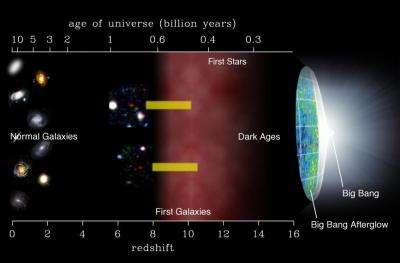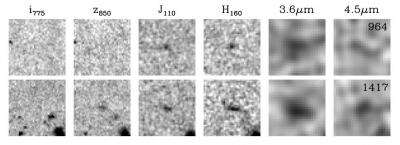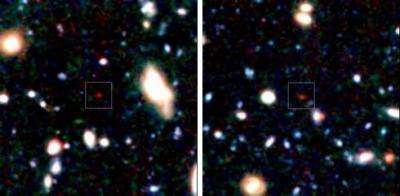This figure shows the relation between redshift and the age of the universe. Redshift occurs when light shifts to longer, redder wavelengths as it travels across the ever-expanding universe. More pronounced redshift means the light has been traveling longer, from farther away; therefore the degree of redshift allows astronomers to know how far back in time they are looking. The two high-redshift galaxies in this study, shown at redshift 7-7.5, are very distant, and their light was emitted when the universe only 700 million years old. The timeline shows several major events in the history of the universe, beginning with the Big Bang and advancing through the haze of the "Dark Ages," the formation of the first stars and galaxies, and eventually arriving at the present day, with normal galaxies like our Milky Way. The yellow bars next to the two high-redshift galaxies show the time period during which most of their stars formed. These galaxies might be the first in the universe to have formed, shortly after the first stars. Credit: Image courtesy Ivo Labbe
Astronomers have taken amazing pictures of two of the most distant galaxies ever seen. The ultradeep images, taken at infrared wavelengths, confirm for the first time that these celestial cherubs are real. The researchers are now able to weigh galaxies and determine their age at earlier times than ever before, providing important clues about the evolutionary origins of galaxies like our Milky Way. The work appears in the October 1 issue of Astrophysical Journal Letters.
Carnegie Fellow Ivo Labbé, along with Rychard Bouwens and Garth Illingworth of the UCO/Lick Observatory at the University of California, Santa Cruz, and Marijn Franx of the Leiden Observatory, examined galaxies in the Hubble Ultra Deep Field (HUDF) using the sensitive Infrared Array Camera (IRAC) aboard NASA's Spitzer Space Telescope. The HUDF, scanned by NASA's Hubble Space Telescope in late 2003, remains the deepest view ever taken at visible and near-infrared wavelengths.
The two galaxies are seen when the universe was just a baby--700 million years after the Big Bang, or five percent of the universe's current age. They belong to a precious small sample of similarly ancient galaxies, discovered two years ago by Bouwens, Illingworth, and Franx and analyzed in-depth in Nature last month. The relative deficit of such far-away luminous sources indicates that this early period is when galaxies were rapidly building up from a very small number of stars to the massive galaxies we see at later times.
This series of images shows two galaxies, dubbed 964 and 1417, which existed 700 million years after the Big Bang. Data from the Spitzer images allowed researchers to calculate their mass, age, distance and star formation rates, making these the youngest and most distant galaxies for which this information exists. From left, the first four columns were taken with cameras aboard the Hubble Space Telescope: i775 and z850 were taken in visible light wavelengths with the Advanced Camera for Surveys (ACS), while J110 and H160 were taken in near-infrared wavelengths with the Near Infrared Camera and Multi-Object Spectrograph (NICMOS). The final two columns, 3.6 ìm and 4.5 ìm, were taken in the mid-infrared with the Infrared Array Camera (IRAC) aboard the Spitzer Space Telescope. Credit: Image from Astrophysical Journal Letters, Vol. 649, p. L67. Copyright 2006 American Astronomical Society, used with permission.
Because there are so few of them, verifying the existence of the distant galaxies and measuring their properties is of paramount importance. The new mid-infrared observations from Spitzer proved essential for Labbé's team, as the analyses were not possible from the Hubble data alone.
"Spitzer is an amazing little machine," Labbé said. "It is a remarkable achievement that a small 0.85-meter telescope can see sources 12.7 billion light years away." Though astronomers have observed faraway galaxies before, these are the most distant for which detailed physical characteristics have been calculated. "I am certain that we would not have been able to confirm the existence of these galaxies, let alone calculate their stellar mass and age, without Spitzer," Labbé added.
The two galaxies were between 50 and 300 million years old--infants themselves, by galactic standards--and weighed about one hundred times less than our full-grown Milky Way. The ages and masses suggest they were already in place much earlier, around 500-600 million years after the Big Bang. They could be among the first galactic systems formed in the universe, shortly after the first stars, meaning that future surveys might reveal luminous galaxies at even earlier times than those measured by Labbé and his colleagues.
The first 500 million years after the Big Bang is known to astronomers as "The Dark Ages," because the universe was filled with clouds of neutral Hydrogen gas that obscured galaxies from our view. Astronomers theorize that newly formed galaxies began to emit enough radiation to burn through the cosmic fog, transforming the universe first into a billowing froth of plasma, and eventually into the transparent state it is today.
These images show a pair of galaxies at redshifts 7-7.5, when the universe was only 700 million years old, or only five percent of its current age. The color images are a combination of an exposure in the optical i-band filter (0.8 micron; here in blue), the optical z-band filter (0.9 micron; here in green), and a combined near-infrared J+H band filter (1.1-1.6 micron; here in red). Because of their extreme distance, the sources are only visible in the near-infrared, and therefore appear red in this image. Credit: Image courtesy Ivo Labbé and Rychard Bouwens
The team investigated whether star formation in the galaxies could have been responsible for clearing this haze, but their calculations suggested that the galaxies in this study are too small and too few. Bouwens said, "In all probability, many more galaxies exist at these early times, but they are fainter than we can see with current telescopes."
Help is on the way. New powerful instruments are to be installed on Hubble next year, and the next decade will mark the rise of the next generation of telescopes, such as the James Webb Space Telescope and planned 30-meter-class ground-based telescopes. Therefore Labbé remains optimistic. "I suspect the HUDF has many more secrets to divulge. With the new instruments and telescopes, we should be able to pry many more discoveries from this relatively tiny sliver of the heavens."
Source: Carnegie Institution


























